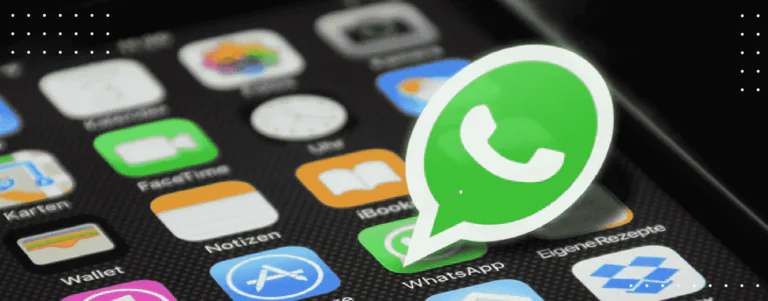What Is GPT-4 and How Can You Use It for Business
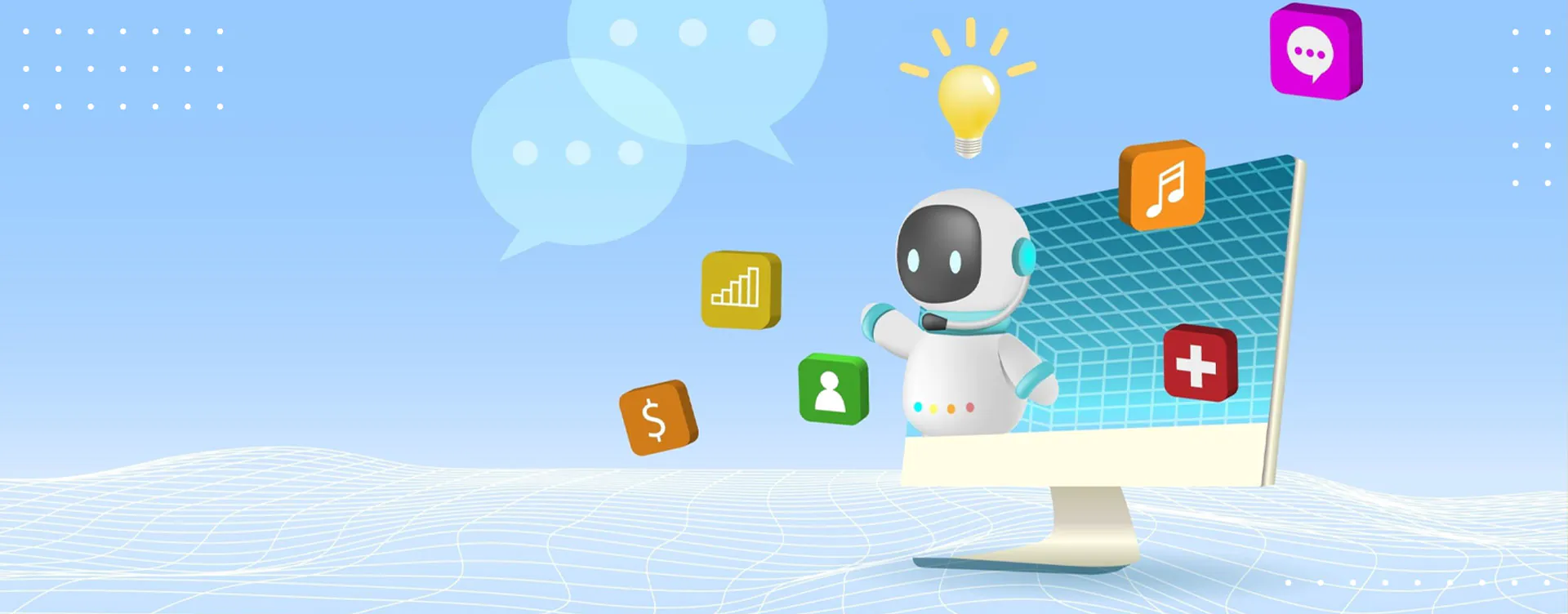
Key takeaways
- Learn more about the difference between СhatGPT vs. GPT4 and reasons why the terms can’t be used interchangeably. As a pleasant bonus, find out the evolution of this technology through the years.
- Let’s explore together what GPT-4 is and in which way it is superior to its predecessors.
- Gain knowledge on how GPT and GPT chatbot OpenAI can be useful for your business.
- Yes, GPT does have many advantages, such as lead generation, content creation, faster time to market, and others, but it’s still not a silver bullet for making your business thrive. Find out what gaps it can help you fill and what are its cons.
- What is the future of GPT and other AI technologies? Get an overview of exciting statistics that only prove GPT’s future development so that you can determine whether the adoption of the technology is worth it.
In an era of global division and societal instability, businesses face unprecedented challenges driven by technological disruptions, changing expectations of customers, stiff competition, and changing economic climate. To adapt, companies are rethinking their strategies, and this is where new technologies come into play, such as machine learning, AI, and, our today’s guest GPT chat.
While concerns about data security persist, many businesses successfully integrate GPT chat into their operations. In this article, we’ll explore how to use ChatGPT for business, find out whether GPT-4 is a beneficial ally or a potential adversary for companies, and examine how it can impact and enhance their performance.
ChatGPT VS. GPT: The difference between concepts and the evolution of models
Artificial Intelligence is evolving by the day, and the Generative Pre-trained Transformers (GPT) series has become a key force in shaping natural language processing capabilities. The rapidly growing adoption of GPT technology and its proven efficiency can be seen from compelling numbers. Thus, according to the report, OpenAI (the research company that created GPT) has projected revenues of $200 million for 2023 and $1 billion by 2024. In 2022, it reportedly made less than $10 million.
Starting with the GPT-1 model and its subsequent versions, these models have shown significant progress in understanding and generating human-like language. To gain an in-depth understanding of GPT essence, the way it evolved, and dispel the confusion of using ChatGPT vs. GPT 4 interchangeably, let’s move onto the section below.
ChatGPT VS. GPT models: overcoming the confusion
GPT (Generative Pre-trained Transformer) is a family of language models using deep learning techniques to generate human-like semantically coherent language. It has been trained on a variety of text sources, including books, articles, websites, and other forms of written content. Contrarily, ChatGPT is a particular use of the GPT model that has been tailored for producing conversational text. This extensive training allows the chatbot to tackle a wide variety of tasks: answering questions, providing explanations, offering creative writing, giving advice, and having conversations on a variety of topics.
You may have probably noticed that these two terms are often mentioned interchangeably. Although these concepts share a standard basis, they are intended for different purposes and have specific nuances that distinguish them. It is essential to clarify these differences because misconceptions often arise due to similar nomenclature. Let’s understand the differences between GPT and GPT chat.
GPT-3 and GPT-4
GPT-3 and its successor, GPT-4, are monumental advances in artificial intelligence. These colossal language models have been meticulously trained on vast amounts of data from the Internet and have amassed knowledge equivalent to terabytes of textual information. Their architecture, inspired by the intricacies of the human brain, makes them among the largest neural networks.
GPT-4 vs ChatGPT
ChatGPT leverages the formidable capabilities of the GPT language model but specializes in the art of conversation. Trained and optimized by human trainers, ChatGPT excels in engaging, context-aware dialogue with users.
In essence, GPT-3 and GPT-4 are text generation models, and ChatGPT harnesses their power for real-time interactive communication. These AI capabilities provide invaluable tools for many applications and usher in a new era of human-AI interaction.
GPT-1, GPT-2, GPT-3, GPT-3.5, and GPT-4: all models explained
Now that you have a firm understanding of ChatGPT and the models that power it, let’s review the various versions of the GPT model, revealing how each has pushed the boundaries of linguistic proficiency and contextual understanding.
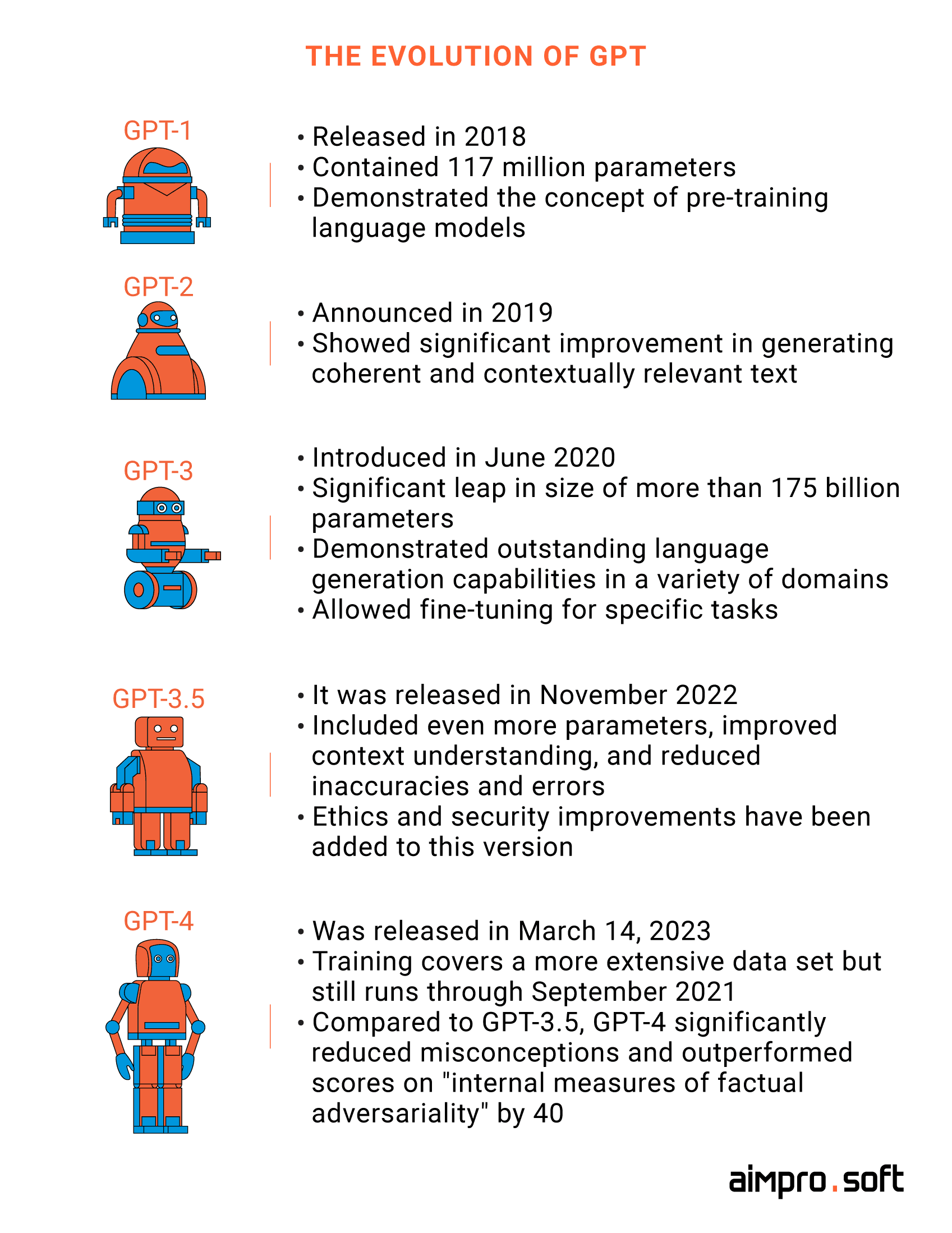
The evolution of GPT
GPT-1 (Generative Pre-trained Transformer 1)
This pioneer laid the groundwork for subsequent iterations, laying the foundation for the evolution of language models.
- Released in 2018.
- Contained 117 million parameters.
- Demonstrates the concept of pre-training language models on large text corpora and fine-tuning for specific tasks.
- Generated coherent text but lacked fine-grained control and sometimes produced nonsensical responses.
GPT-2 (Generative Pre-trained Transformer 2)
This model rewrote the rules by which artificial intelligence can work and gained the ability to generate coherent and contextually relevant text.
- Announced in early 2019.
- Gained significant attention due to concerns about possible misuse.
- Showed significant improvement in generating coherent and contextually relevant text.
- Was not released immediately due to concerns that it could lead to the creation of fake news and misinformation.
GPT-3 (Generative Pre-trained Transformer 3)
GPT-3, with its huge number of parameters (175 billion), has pushed the boundaries of AI-based text generation and sparked discussions about the future of human-AI interaction.
- Introduced in June 2020.
- Significant leap in size – 175 billion parameters.
- Demonstrated outstanding language generation capabilities in a variety of domains.
- Allowed fine-tuning for specific tasks, but mainly used as a generative model.
- Demonstrated improved understanding of context and generated more human-like responses.
- Faced problems with bias and occasional inaccurate information.
GPT-3.5
With its improved conversational capabilities and expanded knowledge repository, it has further cemented its position as a pioneer in the world of language models.
- GPT-3.5, It was released in November 2022
- GPT-3.5 includes even more parameters, improved context understanding, and reduced inaccuracies and errors.
- It includes improved handling of specific topics, enhanced multilingual capabilities, and increased customizability.
- Ethics and security improvements have been added to this version.
GPT-4
This latest version of GPT can not only recognize text but also multimedia, which only enhances the AI capabilities. According to the statistics, chat GPT-4 outperforms the GPT-3.5 version by 40% in an internal evaluation of actual competitive advantage. So, let’s see what GPT-4 represents:
- The GPT-4 was initially released on March 14, 2023.
- Training covers a more extensive data set but still runs through September 2021. This version demonstrated higher competency on various assessments, including the Uniform Law Exam, LSAT, and AP Calculus.
- Compared to GPT-3.5, GPT-4 significantly reduced misconceptions and outperformed scores on “internal measures of factual adversariality” by 40%.
- OpenAI is committed to improving existing systems to align with common human values and to get information from people.
As you can see, GPT is constantly evolving, and each new version becomes more advanced than its predecessor. But we are here to discuss the latest version of GPT, namely GPT-4, so let’s take a closer look at how it outperforms previous versions.
Want to know more about the development of AI? Read our article on one of its main branches and its usage in e-learning sector.
What is GPT-4?
Let’s understand what is chat GPT 4. GPT-4 is a large multimodal model, the latest version of GPT that was released on 14 March 2023, and it powers ChatGPT Plus. According to people who made ChatGPT, it is more robust than the previous version, being able to accept an image as input and understand it like a text prompt, providing improved performance and showing a better understanding of complex prompts. Open AI chatbot can generate, edit, and iterate with users on creative and technical tasks, such as composing songs, writing scripts, or learning the user’s writing style.
New features in GPT version 4
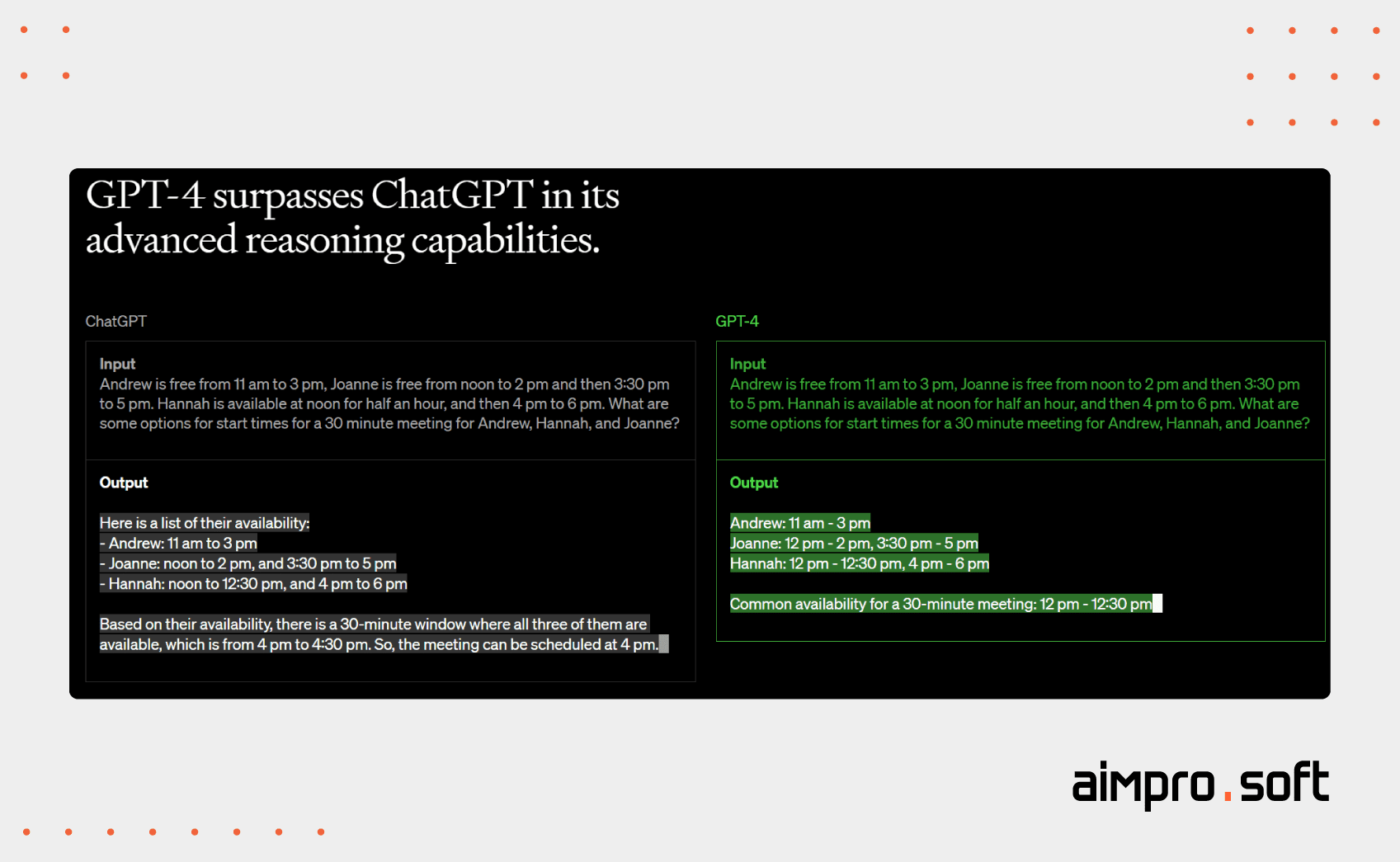
New capabilities of GPT-4. Source: OpenAI
- Enhanced Memory and Context Handling: ChatGPT-4 can process up to 25,000 words of user input, facilitating better conversation comprehension and longer discussions.
- Increased Parameters: GPT-4 uses trillions of parameters, improving learning, prediction accuracy, and overall performance.
- Multimodal Capability: ChatGPT-4 understands images alongside text inputs, allowing interpretation of images (no image output).
- Reinforcement Learning Integration: GPT-4 incorporates advanced reinforcement learning for improved learning from user interactions.
- Complex Problem Solving: GPT-4 effectively tackles intricate problems with multiple steps.
- Advanced NLP: GPT-4 excels in sentiment analysis, translation, and text summarization.
- Reduced Errors: GPT-4 produces fewer “hallucinations” (AI hallucination is when a large language model (LLM) produces false information) compared to GPT-3, resulting in approximately 40% fewer mistakes.
As we can see, the creators of GPT have significantly upgraded the new version. Let’s examine each of the new GPT 4 features in more detail.
What is new in GPT-4?
The GPT 4 version is vastly superior to its predecessors. This has been noted many times by the chat creators themselves:
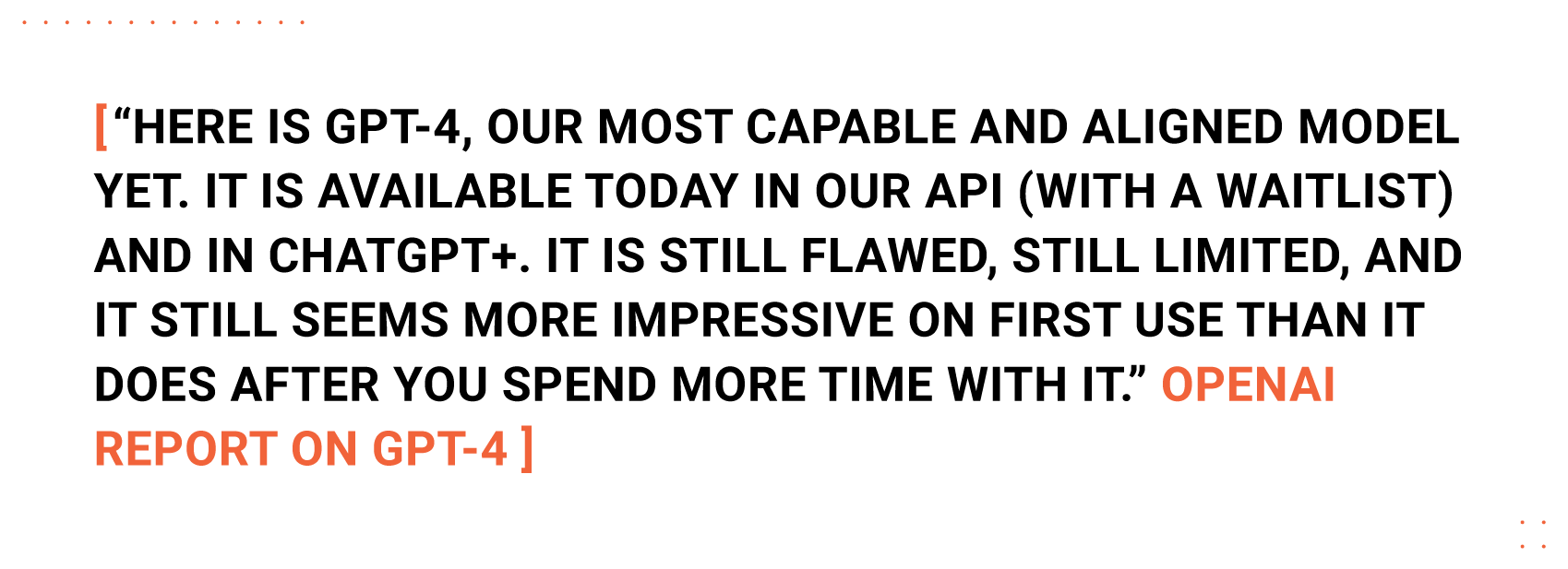
Source: Twitter
Although GPT-4 still has drawbacks, the latest version does include many new benefits and features. Thus, let’s see how does gpt 4 work. Below, we will examine them in-depth and find out what chat GPT is used for.
Multimodal interaction
GPT-4 represents a significant leap in the development of AI language models, as it implements a multimodal structure that allows for more than just textual input to be perceived. This advanced model can efficiently process and interact with images and various multimedia elements. One of the distinguishing features of ChatGPT-4 is its ability to interpret images as queries. By going beyond text, the model can answer questions about images, create descriptive captions, and solve image classification and analysis tasks.
Improved coding capabilities
While GPT-3 demonstrated programming prowess by generating code snippets based on natural language prompts and performing various coding tasks, the evolution of GPT-4 has led to a significant expansion of programming capabilities. This version surpasses its predecessor by becoming significantly better at programming. It is important to note that GPT-4 cannot replace the programmer even with these advances because it lacks the ability to execute code, think critically, solve complex problems, and generate new ideas. Instead, it acts as a helper to complement the programmer’s capabilities, simplifying their tasks.
Improved response accuracy
Compared to its predecessor, chat GPT-4 shows significant progress in generating written responses that are longer, more complete, and more reliable. In its latest version, GPT-4 boasts an impressive increase in response length: it can now generate responses of up to 25,000 words. This significantly increased over the previous version, which had a 4,000-word limit. Moreover, GPT-4’s capabilities are extended to provide detailed recommendations for even the most unusual scenarios.
Expansive language reach
A notable step in developing GPT-4 was the significant expansion of its linguistic capabilities. Compared to its predecessor, GPT-3.5, GPT-4 can understand and generate text in an even more comprehensive range of languages. This significant achievement ushers in a new era in natural language processing.
GPT-4’s multilingualism is further demonstrated by its ability to answer various multiple-choice questions covering 26 languages correctly. This remarkable achievement demonstrates that the GPT-4 is a significant step forward, effectively overcoming language barriers and facilitating intercultural communication.
Persona diversity and manageability
GPT-4 has introduced an interesting feature, “personas” or manageability, that distinguishes it from its predecessor, GPT-3.5. Controllability allows chatbot open AI users to direct the generation of the GPT-4 language to achieve desired results. Unlike GPT-3, which lacked built-in controllability features, GPT-4 has this capability. Using a “system” message, users can pinpoint GPT-4 to specific styles and tasks, a departure from the traditional ChatGPT image characterized by predefined verbosity, tone, and style.
This feature is only available to developers, but OpenAI has announced plans to extend it to ChatGPT users. This evolution aligns with OpenAI’s desire to improve user interaction and control by empowering personalized content created by artificial intelligence.
More сreativity
While GPT-3.5 demonstrates competence in creative content creation, Chatgpt-4 leaps forward, showing increased creativity and coherence. The newest version of GPT-4 allows you to create various forms of artistic expression, including poems, short stories, and essays, with a heightened sense of logical flow and originality.
The GPT-4’s artistic prowess is particularly pronounced in its ability to create complex stories. This advanced model has the ability to not only build a narrative but also flesh it out with distinctive characters and nuanced plot developments. Unlike GPT-3.5, which struggles to maintain a coherent narrative, GPT-4 effortlessly weaves elements together to form coherent storylines.
Let’s now consider chat gpt use cases for business in the next section for a better understanding of whether or not this technology will be useful for your business.
In what business areas is using the GPT AI chatbot useful and profitable?
We can say that Chat GPT has exploded in the global market. Within two months of its launch, it is estimated to have reached 100 million monthly active users. Ordinary users and businesses began to use it for their varying purposes, which is not surprising because it is a reliable help in finding information and generating content and ideas. Let’s take a closer look at what areas of business GPT-4 thrives most in, how to use gpt-4, and chat gpt for business can bring.
Content marketing
GPT-4 powered chat is helpful for copywriting as it can recognize your target audience and their pain points. In order to produce AI-generated content like blog articles, social media captions, and other types of material, 43% of organizations want to utilize ChatGPT for their content marketing purposes.
Chat can map out an article outline and create a list of content topics. Of course, chat still can’t replace a real writer, but it can be a reliable decision-making helper. Using gpt 4 chat can speed up copywriters’ work significantly, which is to the benefit of businesses. The quicker a writer finishes their article, the quicker the article will reach your target audience and bring in new leads.
Translation
How to use chatbot gpt? GPT-4’s extensive translation capabilities give companies a fundamental advantage in language communication, with the ability to understand and generate texts in multiple languages. Businesses looking to enter the global market find GPT-4 indispensable. It helps localize content to ensure that marketing materials, product descriptions, and customer interactions are authentic to different audiences. Real-time translation GPT 4 capabilities simplify cross-cultural interactions, helping to engage audiences without delaying communication.
For example, the company Translated Language Model (T-LM) is using chatgpt for business to provide services for customers to create content in languages other than English, allowing them to take full advantage of GPT-4’s text creation capabilities.
AI-based voice consultants
Another example of how to use chat gpt for business. GPT-4’s capacity to simulate natural and context-aware conversations suits AI-based voice consultants. It can engage users in meaningful dialogues, offering personalized recommendations and assistance. This enhances user interactions with voice-enabled applications and devices.
A successful example of implementing such a feature from a GPT-4 is the company Be My Eyes. Since 2012, Be My Eyes has been pioneering technology for blind and visually impaired people, comprising over 250 million individuals. This Danish startup facilitates connections between those with visual impairments and volunteers, aiding them in various daily tasks such as recognizing products or maneuvering through airports.
eLearning
There are many advantages to using ChatGPT for e-learning platforms. First, it enables teachers to design more dynamic and engaging learning programs. Learners who use ChatGPT in internal learning systems can converse with the model, asking questions, requesting clarifications, and getting immediate feedback. Finally, ChatGPT enables on-demand support and assistance. Even when it’s not working time, trainees are always welcome to interact with the open ai chatgbot. They can get answers to their questions or request more materials for further instruction.
Khan Academy has already successfully implemented the usage of GPT-4 in its learning platform. The goal of the nonprofit organization Khan Academy is to make high-quality education accessible to everyone, everywhere. For pupils of all ages, the organization provides hundreds of classes in math, science, and the humanities. Today, Khan Academy makes the announcement that Khanmigo, an AI-driven assistant that serves as both a virtual tutor for students and a classroom assistant for teachers, will be powered by GPT-4.
Programming

And here is one of the most popular cases of chat gpt uses for business. Frontend developers often use GPT for coding hints. There are also tools for developers, which are based on GPT; the programmers use such tools for the function of code continuation; the tool offers to continue the basic elements of the code. For example, the MarsX platform enables users to create software applications without the requirement for conventional coding and by utilizing the GPT chat interface. This feature from GPT can significantly speed up the product development process during downtime and increase the productivity of engineers.
So, we have looked at the chat gpt commercial use examples and how to use chatgpt-4. It can be a good assistant in work processes, increase employees’ productivity, and certain routine tasks easier. But GPT has not only pros but also cons. Let’s consider them in the next section.
Doubting whether you should implement GPT in your project? Conducting a discovery stage can help dispel your concerns. Learn more about the discovery stage and its benefits in our article on the topic.
Business advantages and disadvantages of the OpenAI GPT 3 Chatbot
Even though version 4 of GPT has been released, companies are still using GPT-3 instead of GPT-4 for several reasons. If GPT-3 is already integrated into a company’s various business applications and systems, then moving to GPT-4 may require significant adjustments to the existing infrastructure. Also, chat GPT-3 has a proven history of performance and reliability. Companies may only move to GPT-4 once its capabilities are proven. In the end, GPT-3 may remain sufficient for many use cases
As businesses embrace the transformative potential of GPT-3 chat, a nuanced understanding of its benefits and flaws becomes paramount. This section examines the promising benefits and potential drawbacks of GPT-3 chat for businesses.
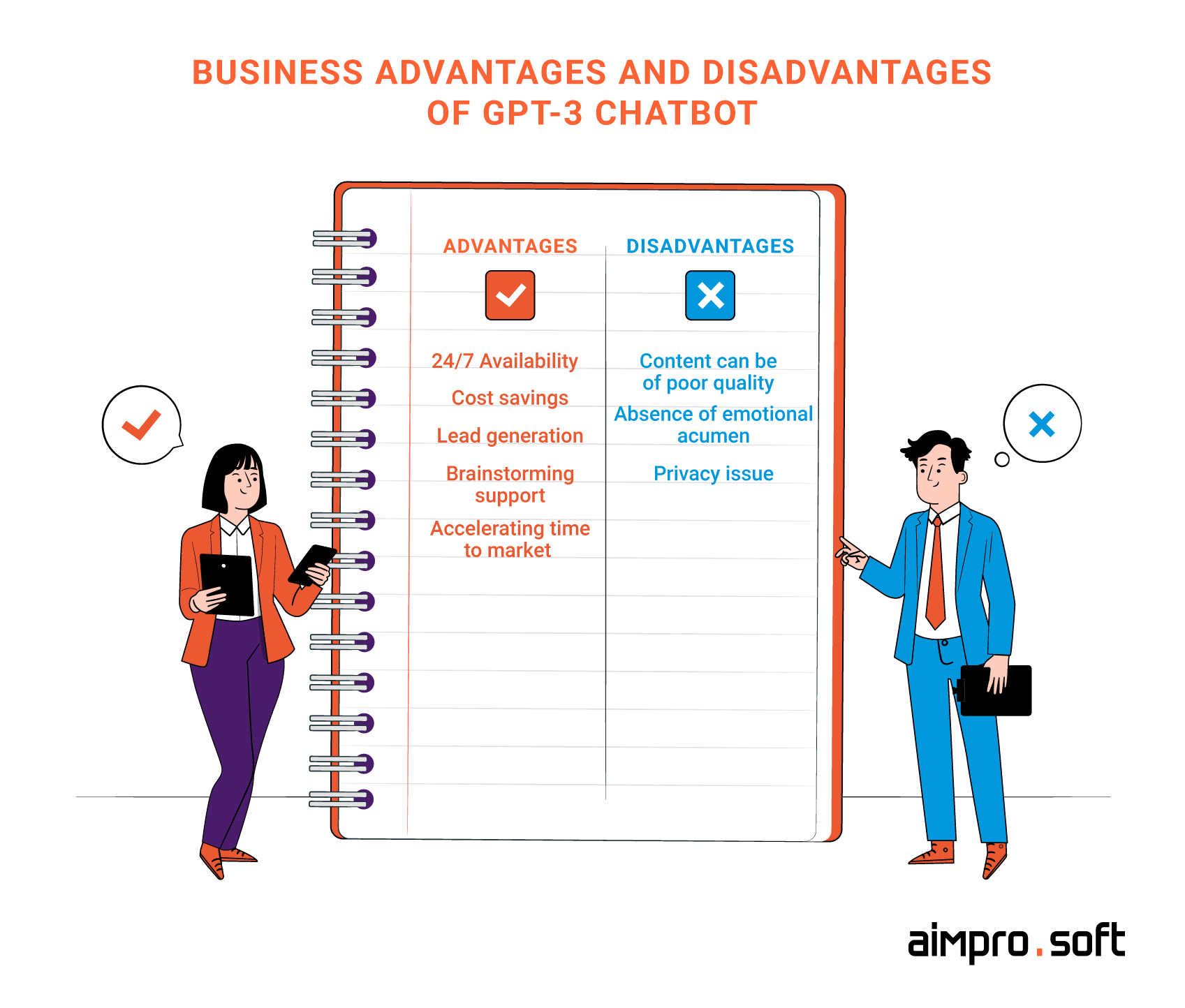
Business advantages and disadvantages of GPT-3 Chatbot
Advantages
24/7 Availability
The round-the-clock availability of the chatbot provides a crucial advantage to businesses in the form of continuous customer support. Customers can get assistance and information anytime, irrespective of time zones or traditional working hours. As a result, businesses can offer timely solutions to customer queries, issues, or concerns, significantly enhancing customer satisfaction. This unwavering accessibility contributes to reliability, reinforcing trust between customers and businesses and improving customer loyalty.
Cost savings
Integrating the GPT-3 chatbot into your customer support system offers significant potential for cost savings. Automating routine customer interactions reduces reliance on large numbers of support staff. This combination of cost-effective automation and improved customer service improves the overall financial benefit. The cost savings achieved by using Chat-GPT are estimated at $8bn by the end of 2023.
Lead generation
chat GPT 3 chat goes beyond conventional customer interactions by facilitating efficient lead generation. The chatbot can intelligently collect and analyze user information and preferences during customer conversations. This valuable data analysis is a foundation for businesses to fine-tune their marketing efforts. With insights from these interactions, businesses can create personalized marketing campaigns, offer tailored promotions, and recommend products that align with customer preferences. This precision-driven approach enhances the likelihood of successful lead conversions and elevates the overall effectiveness of marketing strategies.
Brainstorming support
GPT-3 assists employees in times of stagnant work by helping them brainstorm. When creative inspiration is lacking, employees can chat with it to spark new thoughts, explore fresh perspectives, and ignite innovative thinking. Employees can enter their parameters, aspirations, or challenges, and GPT-3 responds with various possible developments. This dynamic interaction allows employees to break down mental barriers, stimulates creativity, and encourages them to explore avenues they may not have considered.
Accelerating time to market
The GPT-3 chatbot is a skillful accelerator, enabling you to launch various essential business processes with extraordinary speed. Whether building a website, developing an attractive design, creating compelling advertising copy, or finding potential customers, the chatbot is at its best. Deftly handling these tasks, the technology acts as a catalyst, significantly reducing the time to market for products or services.
Disadvantages
Content can be of poor quality
Relying on the Internet’s vast array of textual data, Chat GPT faces a challenge. Its results may be inaccurate and biased, its memory expires in 2021, and the data it provides may need to be updated. While companies can take precautions to mitigate these concerns, the degree of control over the content generated remains limited. As a result, a delicate balance has to be struck between utilizing the model’s capabilities and maintaining the required quality.
Absence of emotional acumen
Chat GPT’s emulation of natural conversation is notable; however, its adeptness in grasping emotional nuances is limited compared to a human interlocutor. The intricacies of subtle communication cues may elude the model, leading to user frustration or misinterpretation. This calls for understanding the model’s limitations and refining user expectations when seeking nuanced interactions.
Privacy issue
Interacting with Chat GPT involves sharing data, which raises privacy and security issues. The need to protect sensitive information from unauthorized access requires robust security measures. Businesses must prioritize data protection to prevent possible breaches compromising user privacy. In this way, organizations can gain users’ trust and maintain the integrity of their interaction with the chatbot.
While the allure of GPT-3 chat’s advantages holds undeniable appeal for businesses seeking efficiency and innovation, the conversation would only be complete by acknowledging its inherent limitations. As we weigh the benefits against the potential pitfalls, it becomes clear that while GPT-3 chat opens doors to remarkable possibilities, it remains an evolving technology. Imperfections and challenges persist, reminding us of the importance of measured implementation and vigilant oversight.
Future of ChatGPT
It is projected to reach a staggering $1.34 billion by 2024. This predictive analytics emphasizes the key role of chatbots and paints a vivid picture of the opportunities for the evolution of chatbot GPT. This remarkable growth carries profound implications. It prompts both technologists and investors to intensify their efforts in enhancing chatbot capabilities and tapping into unexplored opportunities.
Here are some more promising statistics that only confirm the development and continued growth of this technology:
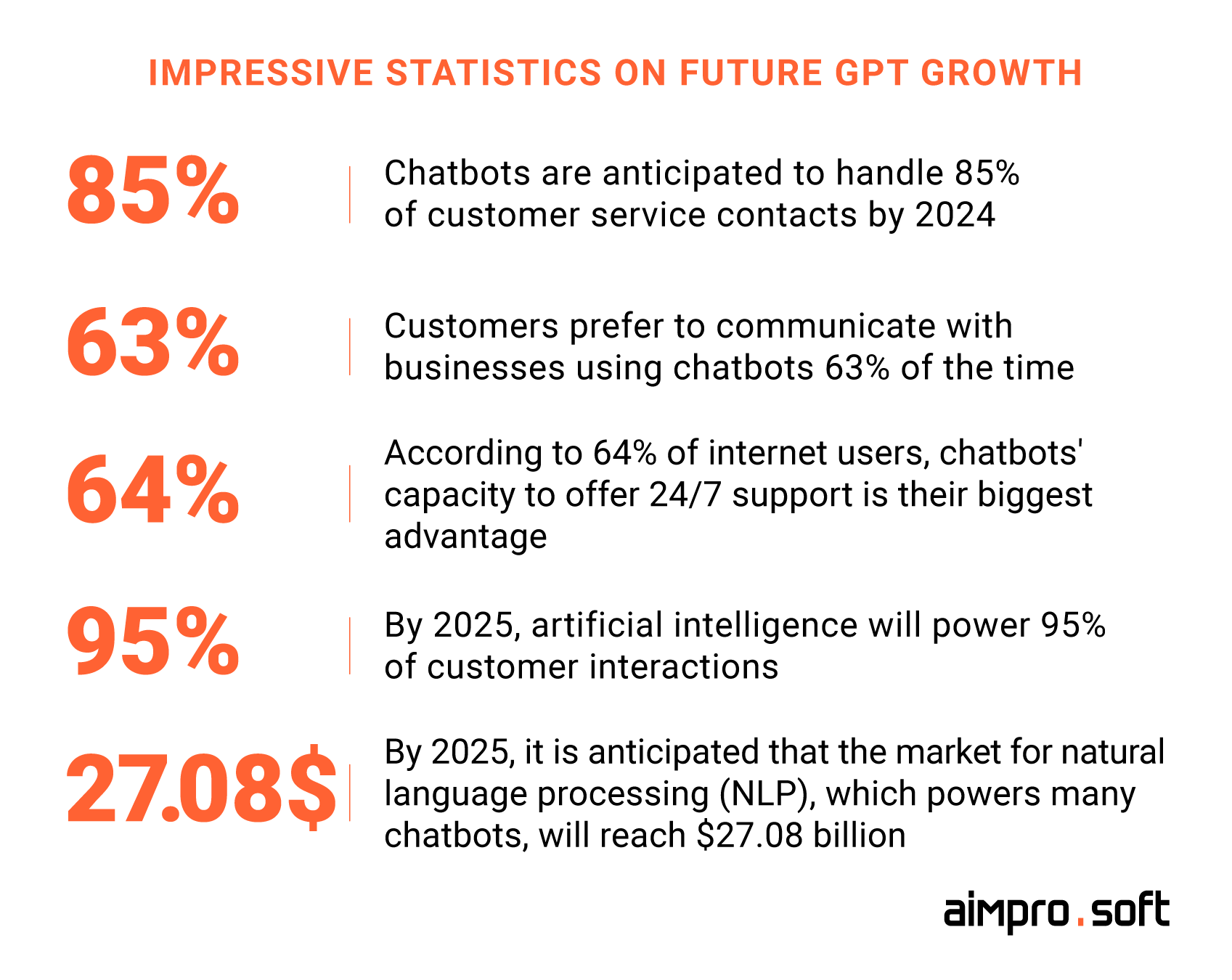
GPT growth statistics. Source: Zipdo
In essence, GPT-4 possesses the capacity to overhaul chatbot technology at its core. Empowering developers to forge conversations that resonate with naturalness, GPT-4 stands poised to orchestrate a significant leap in the evolution of advanced chatbots. These heightened capabilities could herald a new era where chatbots adeptly discern conversation context and craft responses akin to human interactions. This transformative potential redefines the chatbot landscape and has far-reaching ramifications for human-chatbot interactions, fostering more impactful and tailor-made conversations.
How can Aimprosoft help to use GPT for your project?
Aimprosoft has over 18 years of experience in the dynamic IT industry. Our track record of over 600 successfully completed projects makes us a trusted and experienced player in this field. Transparency and customer centricity are at the core of our values. At Aimprosoft, we approach every cooperation with unwavering open communication and adapt to the specific requirements of our clients. We also have a team of machine learning experts on board. They can create a unique, secure GPT-based solution that fully meets your vision.
Aimprosoft expertise that you can use to unleash your business potential
We have the expertise to customize a GPT-based chatbot to meet your requirements or integrate GPT into an existing product. In addition, we offer our support to enable the chatbot to access valuable customer data from your database, enhancing its capabilities and enriching user interactions. Our machine learning department also has extensive experience with NLP. GPT are the generalized language models that can perform equally well on a set of NLP tasks. However, if you want to create a solution for a specific task, using custom models without dependence on OpenAI products may be better. Our experienced team works closely with these technologies, allowing us to utilize the full potential of NLP in your projects. Our NLP-related services include:
- Text classification. The goal of text classification is to automatically classify the text or text documents into one or more defined categories.
- Text summarization. It is the technique for generating a concise and precise summary of voluminous texts while focusing on the sections that convey useful information without losing the overall meaning.
- Machine translation. It is an automated translation of text performed by a computer.
- Event extraction. It is the process of gathering knowledge about periodical incidents found in texts, automatically identifying information about what happened and when it happened.
- Entity extraction / Named-Entity Recognition. It is a text analysis technique that automatically identifies or extracts entities, like product name, event, and location. It’s used by search engines to understand queries, chatbots to interact with humans, and teams to automate tedious tasks like data entry.
- Text generation. It is the task of generating text with the goal of appearing indistinguishable from human-written text, such as smart composition, content creation, or chatbots.
- Sentiment/emotion analysis. It is a text analysis technique to determine whether data is positive, negative, or neutral. Sentiment analysis is often performed on textual data to help businesses monitor brand and product sentiment in customer feedback and understand customer needs.
- Question answering. It involves providing direct answers to questions posed by users in a natural language format.
- Paraphrase generation. It is the task of generating an output sentence that preserves the meaning of the input sentence with variations in word choice and grammar.
- Parts-of-Speech tagging. It is a popular Natural Language Processing process that refers to categorizing words in a text (corpus) in correspondence with a particular part of speech, depending on the definition of the word and its context.
- Grammar check. NLP models check the grammatical structure of sentences based on morphological processing and syntactic processing.
- Large Language Models (LLMs). They are deep learning algorithms that can perform a variety of natural language processing (NLP) tasks. GPT, WizardLM, LLaMA, and RoBERTa are examples of LLMs.
Contact us, we will review your case and find the best solution for you.
CONTACT USConclusion
In a world hurtling towards ever-changing horizons, the fear of being left behind by rapid technological growth is a tangible reality for the majority of businesses. In this dynamic world where change is the only constant, harnessing the potential of transformative technologies like GPT becomes a significant strategic move. GPT technology still needs improvement, but nothing ventured, nothing gained. Many companies have embraced GPT in their projects and have obtained game-changing results. You may always get in touch with Aimprosoft, and we will create a project based on GPT for you that is of the highest caliber if you want to benefit from all the advantages of this AI.
FAQ
How to use ChatGPT?
ChatGPT is accessible via an online platform or API provided by OpenAI. You can visit the OpenAI website or access the API through your preferred development environment to utilize it. Users interact with the model by inputting text prompts or questions. ChatGPT processes these prompts and generates text-based responses, making it a versatile tool for various applications such as chatbots, content generation, and more.
What kind of developers do I need to implement ChatGPT in my business?
Implementing ChatGPT effectively typically requires a team of skilled developers with expertise in natural language processing (NLP), machine learning, and software integration. These professionals should be proficient in programming languages like Python, commonly used in AI development.
Is ChatGPT free to use?
OpenAI offers both free and paid access to ChatGPT. While you can use ChatGPT for free, OpenAI offers subscription plans such as “ChatGPT Plus.” Subscribers receive faster response times and priority access to new features and enhancements. These paid plans are designed to enhance the ChatGPT experience for users requiring more excellent and reliable access.
What models of GPT have been released to date?
OpenAI has introduced several iterations of the Generative Pre-trained Transformer (GPT) model. The following can be distinguished among them:
GPT-1: the original model, which laid the foundation for subsequent versions.
GPT-2: a significant enhancement known for its impressive text generation capabilities.
GPT-3: is a pioneering model that sets new standards in language understanding and generation.
GPT-3.5: an improved version that continues to expand the capabilities of the language.
GPT-4: a multimodal large language model, the fourth in the GPT series



